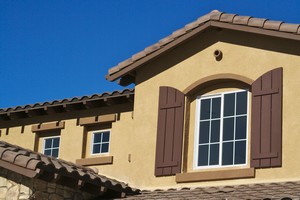What You Should Know Before You Paint Stucco

Stucco is a hard surface building material similar to concrete; like concrete, it is made of cement, but has lime and sand mixed in as well. It is a breathable material full of voids that permit air and water vapors to permeate. When stucco is left untreated it moisture from the atmosphere passes freely through the material.
Paint and Stucco: Not a Good Combination
While you would resort to paint to protect many kinds of materials, stucco is one material that is not well matched with paint. For starters, because it readily absorbs moisture, the stucco sucks up all the paint and you need to apply many coats to cover the surface. The problem is most severe in humid climates. A bigger problem occurs when the moisture that has been absorbed into the stucco gets trapped beneath the sealing layer of paint: The result is unsightly blistering and peeling paint. As bad as this looks, what you can't see is even worse; the trapped moisture can wick into the wood framing of your home causing the wood to rot. The end result is dangerous mold which can only be removed by tearing out and rebuilding the affected areas.
Once a stucco house is painted, it can be a nightmare to maintain. Because of the relentless peeling, the exterior will need to be scraped, cleaned, primed and repainted every few years.
So what's the alternative?
Stucco is a durable material that can be left as is; if moisture in the air can pass freely through its porous surface, it will not become trapped inside the building. Stucco can be cleaned as needed with an approved cleaning solution and low water pressure. If cracks occur in the surface, they should be repaired.
Stucco comes in shades of white, neutrals and earth tones. If you are unhappy with the color of your stucco home it can coated with a Portland cement and water mixture that has been tinted with color pigment of your choosing.
However, If you are still insistent about painting your stucco, choose an acrylic latex paint or elastomeric product formulated to resist blistering and peeling. These paints offer the greatest levels of moisture resistance. Elastomeric paints, in particular, have great elastic properties that allow them evenly coat the nooks and crannies found on stucco. Other good alternatives include penetrating masonry stains or clear finishes; they have the ability to penetrate and seal the gaps of a rough stucco surface.
Before choosing and apply a product, talk to the professionals at your local home improvement or paint store for recommendations on products that are well suited to your climate and any previous finishes that may exist on the stucco. The most important thing to keep in mind is that any kind of paint will compromise the permeable nature of stucco and lock in atmospheric moisture.
